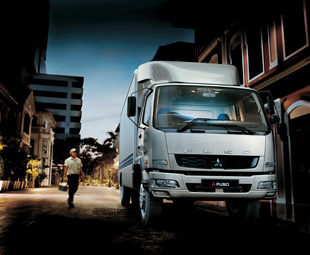Fuso on HCVs

From bigger vehicles to supermarkets and changing supply chains, Fuso’s product manager, Duncan Prince, and national sales manager, Ziyad Gaba, explain to GAVIN MYERS why the HCV market is beginning to change.
What has been the major trend in the heavy commercial vehicle (HCV) sector over the last year?
Customers are buying more eight- to nine-tonne payload capacity vehicles than six- to seven-tonne vehicles. In many areas customers are moving towards more efficient vehicles: bigger, heavier and longer. Everyone wants maximum dimension bodies in order to carry as much as possible.
Does this move to bigger vehicles impact on other market categories?
We have seen a significant decline in the size of the HCV segment, which probably hasn’t come to an end yet. These HCV volumes have been substituted principally in the extra-heavy commercial vehicle (EHCV) segment. Interestingly, a significant reason for this is the new distribution model adopted by most of the supermarket chains.
Tell us about that …
In the past, many suppliers to supermarket chains would deliver directly to the supermarket location, with numerous HCV-segment trucks making two or three small drops in a day. This has changed significantly, in that suppliers now deliver a complete interlink load of product to the supermarket distribution centre.
From here, a consolidated mixed load for one supermarket only is made up and then an EHCV vehicle, be it a 6×2 rigid or an articulated tractor and trailer combination, makes a single drop, rather than multiple drops.
Is this the only major buying-behaviour trend you’re seeing?
Customers are also buying in a more pragmatic fashion, where vehicles are bought either to fulfil the needs of a dedicated contract, or to replace units at lease maturity or at the end of the vehicle’s planned operational life. We see more small-volume, consistent purchases spread over a year, rather than the single big-hit purchases of 50 or more units at a time.
This must have a knock-on affect on replacement cycles …
Again, customers in this segment are generally looking to get more efficiency and productivity out of their vehicles, but there are distinct differences in this segment’s customer behaviour.
 The trend we have picked up is that the larger fleets, with high annual mileages, seem to be replacing their vehicles every three to four years on average – in line with what we expect. However, the individual buyers and smaller fleets seem to be holding onto their vehicles for longer periods, obviously trying to get as much out of their vehicles as they can during these tough business times and conditions.
The trend we have picked up is that the larger fleets, with high annual mileages, seem to be replacing their vehicles every three to four years on average – in line with what we expect. However, the individual buyers and smaller fleets seem to be holding onto their vehicles for longer periods, obviously trying to get as much out of their vehicles as they can during these tough business times and conditions.
So how have sales in the sector been this year so far?
Overall, the market seems to show no growth compared to last year, with many manufacturers showing negative growth. Fuso has had an exceptional year thus far; within this particular segment, sales are up 69 percent year-on-year (Fuso sales in this segment during 2013 were very good, they were up 21 percent compared to the 2012 number). If we continue on this trend, we expect to see numbers close to the 2008 level, which was Fuso’s all-time high in terms of sales numbers.
Do you think these numbers will continue into the near future?
While we, at Fuso, are bullish about our own growth within the segment, we believe the total market will struggle to grow significantly over the next two years, given the current economic conditions and changing market conditions we’re finding in South Africa.
I’m sure Fuso will not take to resting on its laurels, though … How does the company intend to remain competitive?
By continuing with our already comprehensive offering … First, we offer a choice of four basic models in the HCV segment with appropriate specification for the South African market – they offer outstanding performance in a simple easy-to-operate package. This also allows exceptional reliability; customers expect their trucks to consistently get up and go every time the driver turns the key, and this is exactly what our trucks do for them.
We also have more than adequate national dealer coverage, numerous in-house finance options, including guaranteed buybacks (depending on operational requirements) and an array of maintenance packages to ensure maximum customer utilisation of the truck throughout its entire useful working life.
Thanks very much, and all the best in taming this rapidly changing sector.
Published by
Focus on Transport
focusmagsa




